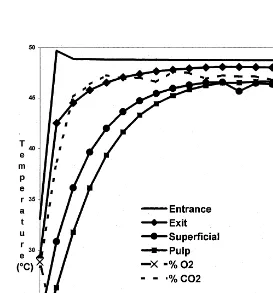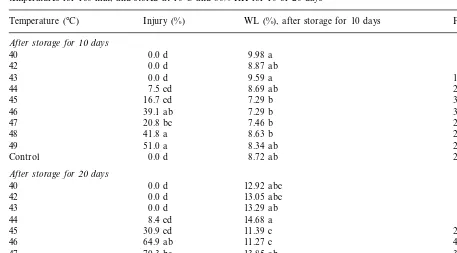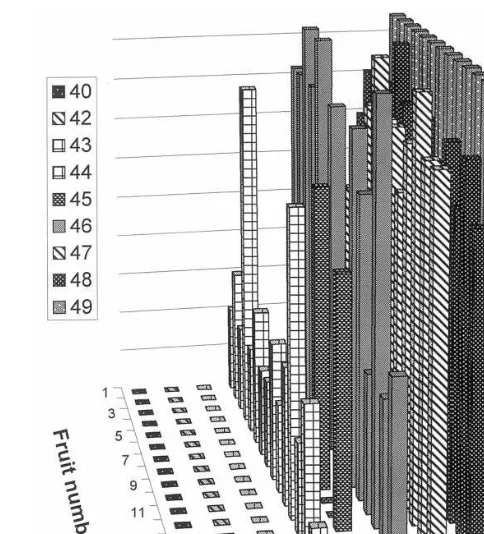Tolerance and quality of mango fruit exposed to controlled
atmospheres at high temperatures
Dora Ortega-Zaleta, Elhadi M. Yahia *
DIPA,Facultad de Quı´mica,Uni6ersidad Auto´noma de Quere´taro,Quere´taro76010,Mexico
Received 15 June 1999; accepted 18 June 2000
Abstract
‘Manila’ mangos (Mangifera indica L.) were exposed to controlled atmospheres (CA) (0 kPa O2+50 kPa CO2) at
40, 42, 43, 44, 45, 46, 47, 48 and 49°C for 160 min, cooled in water at ambient temperature, and then stored at 10°C and 80% RH for up to 20 days. Relative to non-treated controls, fruit heated at 40, 42 and 43°C did not show any external or internal injury, while those subjected to 44°C developed slight injury after 10 days and severe injury after 20 days. Fruit subjected to ]45°C had severe injury after storage for 10 days and the injury increased very significantly after storage for 20 days. Fruit exposed to 49°C and stored for 20 days had 100% injury. Weight loss was similar in control and in heat-treated fruit. Fruit firmness losses decreased as the temperature increased to 46°C and then increased. Chroma of exocarp and mesocarp decreased, while hue angle value of mesocarp increased as temperature increased. Based on the extent of fruit injury, CA is tolerated by ‘Manila’ mangos at B44°C, but not at ]44°C. © 2000 Elsevier Science Ireland Ltd. All rights reserved.
Keywords:Mangifera indica; Postharvest; Hot air; Quality; Color, Texture
www.elsevier.com/locate/postharvbio
1. Introduction
Mango fruit in Mexico can be infested with several insects, among which the most important are the fruit flies Anastrepha ludens and A. obli -qua. These are quarantine pests in several tropical and subtropical products. Mango fruit exported to the USA and Japanese markets are treated with hot water at 46.1°C for 65, 75 or 90 min
(depending on fruit weight). This treatment, espe-cially for longer periods, accelerates ripening and causes fruit injury (Campos and Yahia, 1991). ‘Keitt’ mangos can tolerate extreme atmospheres (50.5 kPa O2and/or ]50 kPa CO2) for up to 5
days at 20°C (Yahia, 1993, 1994, 1998; Yahia and Tiznado-Hernandez, 1993; Yahia and Vazquez-Moreno, 1993; Yahia and Paull, 1997; Yahia et al., 1989). These atmospheres can kill several in-sects (Paull and Armstrong, 1994; Yahia, 1998). Whiting and Van Den Heuvel (1995) reported that controlled atmospheres (CA) significantly re-* Corresponding author. Tel./fax: +52-42-156867.
E-mail address:[email protected] (E.M. Yahia).
duced the duration of exposure required for 100% mortality of Tetranychus urticae Koch. From a practical standpoint, a quarantine treatment should be accomplished in the shortest period possible. Insect mortality is faster when modified (MA) and CA are applied at higher temperatures (Paull and Armstrong, 1994; Yahia, 1998). Mor-tality of third instar larvae of A. ludens was significantly higher when larvae were heated in 44°C in 1 kPa O2than when heated in air (Shellie
et al., 1997). A 100% mortality of third instar larvae ofA.ludenswas accomplished in 3.5 h in 1 kPa O2 at 44°C compared with 5 h in air (Shellie
et al., 1997). Mango fruit is relatively tolerant to heat (Paull and Armstrong, 1994), and thus quar-antine treatments were developed based on the use of hot water and hot air (Heather et al., 1997; Paull and Armstrong, 1994). In addition to the control of insects, CA and heat treatments may provide other advantages. For example, pre-stor-age of ‘Keitt’ mangos in air at 38°C for 24 or 48 h increased the tolerance of the fruit to chilling (McCollum et al., 1993).
There is no reported research on the evaluation of the response of mango fruit quality to insectici-dal CA at high temperatures. The objective of this work was to evaluate the responses and quality of ‘Manila’ mangos heated in the presence of CA.
2. Materials and methods
2.1. Materials and treatments
Physiologically mature mango fruit (Mangifera indica cv. Manila) were harvested 90 days after fruit set in the Cotaxla Research Station, Ver-acruz. They were immediately transported to the laboratory, and kept at 10°C for 24 days, after which they were warmed to ambient temperature (25°C), sorted for absence of defects, and classified according to size into lots of 30 fruit each. Fruit weight was recorded and averaged 188.592.9 g. Treatments consisted of exposure to CA (0 kPa O2+50 kPa CO2) at 40, 42, 43, 44, 45,
46, 47 and 49°C and 50% RH for a total treat-ment time of 160 min. Non-treated fruit were maintained at 20°C before storage.
2.2. Heat and CA treatments
CA at high temperatures was maintained inside a gas tight temperature controlled chamber (Yahia et al., 1997; Yahia and Ortega, 2000). Relative humidity was kept at 50%. Calibration gases used were: 100 kPa N2 (obtained from
In-fra), 2.09 kPa O2+39.54 kPa CO2+58.37 kPa
N2 (obtained from Aga), 4.99 kPa O2+5.1 kPa
CO2+89.9 kPa N2(obtained from Aga), and 9.95
kPa O2+9.98 kPa CO2+80.07 kPa N2(obtained
from Praxair). Immediately after heat treatments, fruit were cooled for 30 minutes in water at ambient temperature, dried, and then treated and non-treated fruit were stored in air at 10°C and 80% relative humidity.
2.3. E6aluation
through parallel to each side and 3 color measure-ments were made on the flat pulp surface of each half.
2.4. Statistical analysis
The experiment examined the effect of CA (0.5 kPa O2+50 kPa CO2) combined with eight
tem-peratures (40, 42, 43, 44, 45, 46, 47 and 49°C, in addition to a non-heated control) and one expo-sure time (160 min). Each treatment consisted of 15 replicate fruit. Unheated fruit were taken as control. The results were submitted to analysis of variance and the mean values were compared using Duncan’s Multiple Range Test.
3. Results and discussion
An example of the changes in the average tem-peratures of air in the chamber (supply and return temperatures), fruit pulp and surface tempera-tures, and O2 and CO2 concentrations recorded
during a treatment with 0 kPa O2+50% kPa CO2
at 46°C for 160 min is shown in Fig. 1. The time taken for the average air supply and exit (return) temperatures to be within 0.5°C of the desired temperature for all treatments was 10 and 80 min, respectively. Fruit surface (superficial) and pulp temperatures increased slowly and reached desired temperatures after 80 – 100 min for fruit heated at 544°C, but was still 2 – 3°C below
Table 1
Average fruit injury (%), weight loss (WL) and firmness of ‘Manila’ mangos exposed to CA (0 kPa O2+50 kPa CO2) at different temperatures for 160 min, and stored at 10°C and 80% RH for 10 or 20 daysa
WL (%), after storage for 10 days
Temperature (°C) Injury (%) Firmness (N)
After storage for10days
9.98 a
After storage for20days
12.92 abc
Control 0.0 d 4.33 ef
aMeans with the same letter indicate no statistical differences.
the chamber temperature at the end of the treat-ment period in fruit heated at ]45°C. The O2
concentration decreased and the CO2
concentra-tion increased fairly fast and reached the desired levels after 10 and 20 min, respectively.
After 10 days of storage at 10°C and 80% RH, no injury was observed in fruit heated at 40, 42 or 43°C, slight injury was observed in fruit exposed at 44°C, and severe injury was observed in fruit exposed at ]45°C (Table 1, Fig. 2). After 20 days of storage at 10°C and 80% RH, injury increased in fruit exposed at 44°C and was very severe in fruit exposed at ]45°C (Table 1, Fig. 3). Injury was in the form of peel discoloration and scald, and extended to the mesocarp in the severe cases. No significant damage was observed in kiwifruit heated in air at 40°C, or in CA (0.4 kPa O2+20 kPa CO2) at the same temperature
for 7 h and then hydrocooled (Lay-Yee and Whit-ing, 1996). However, kiwifruit exposed to 44°C in CA for 7 h without hydrocooling or for 10 h with
Fig. 3. Injury scores (%) of individual ‘Manila’ mango fruit exposed to 0 kPa O2+50 kPa CO2at 40 – 49°C and 50% RH for 160 min, and stored for 20 days at 10°C and 80% RH.
hydrocooling had slight and moderate damage, respectively. ‘Tommy Atkins’ mangos treated with forced air at 51.5°C for 125 min and stored for 1, 2 or 3 weeks at 12°C followed by 21°C until soft – ripe lost 1% more fresh weight compared to the non-treated control and developed trace amounts of peel pitting (Miller et al., 1991). Treated fruit reached the soft – ripe stage one day earlier than the control regardless of the storage duration, and had a lower incidence and severity of stem-end rot and anthracnose. Inconsistent results were re-ported on the responses of grapefruit to 44°C in 1 kPa O2 for 24 h (Shellie et al., 1997). In one
experiment panelists rated the flavor of grapefruit heated in low O2 as significantly inferior to the
non-heated, control fruit. ‘Fuerte’ avocados ex-posed to hot air at 43°C for 3.5 – 12 h did not soften or ripen normally and exhibited severe surface browning after a 14-day simulated transit period at 7°C followed by a 4-day simulated marketing period at 20°C (Kerbel et al., 1987).
After 10 days of storage in 10°C and 80% RH weight loss ranged between 7.2 and 10% (Table 1). Weight loss was slightly lower at 45, 46 and 47°C than in other temperatures. After 20 days of storage weight loss ranged between 11.3 and 14.7%, and was also slightly lower at 45 and 46°C than at other temperatures.
Flesh firmness after 10 days of storage ranged between 4.3 and 36 N (Table 1), and was higher at ]44°C than at the lower temperatures. The soften-ing of fruit heated at 40, 42 and 43°C was much greater than the control. Flesh firmness was lower after storage for 20 days compared with storage for 10 days. Non-treated fruit stored for 20 days had a firmness of 4.3 N, while treated fruit had a firmness of 3.5 – 40.2 N (Table 1). Temperatures of 45, 46 and 47°C resulted in the firmest fruit. Flesh firmness of kiwifruit treated at 40°C in air for 10 h or in CA (0.4 kPa O2+20 kPa CO2) for 7 and
There were no differences in externalL* values between treatments after 10 and 20 days of stor-age (Table 2). Internal L* values changed only slightly in response to the different treatments and were similar in fruits evaluated after 10 or 20 days. External chroma values slightly decreased after 20 days of storage compared to when fruit were evaluated after 10 days of storage, and slightly decreased as the temperature increased. Internal chroma values were higher after 10 days than after 20 days of storage and decreased as the temperature increased. Hue angle values slightly increased after 20 days of storage compared to storage for 10 days at 10°C, and also slightly increased as the temperature increased. Hue angle value, which is the angle from the +aaxis to the ray from the origin to thea*,b* point, is a good estimate of the green to yellow color turn
(McGuire, 1992). Generally, increasing the tem-perature increased the yellowness of the fruit (as indicated by the hue angle values), but decreased the color intensity (as indicated by chroma).
4. Conclusions
‘Manila’ mango fruit did not present any injury when exposed to CA (0 kPa O2+50 kPa CO2) at
40, 42 and 43°C and 50% RH for 160 min and then stored at 10°C and 80% RH for up to 20 days. However, fruit were injured when exposed to ]44°C and stored for up to 10 days, and the injury increased when fruit were evaluated after 20 days of storage at 10°C and 80% RH. Results presented in this paper show that CA (0 kPa O2+50 kPa CO2) at ]44°C for 160 min, which
Table 2
External and internal color of ‘Manila’ mangos exposed to CA (0 kPa O2+50 kPa CO2) at different temperatures for 160 min, and stored at 10°C and 80% RH for 10 or 20 daysa
After storage for10days
102.7 abc 76.6 ab 65.6 abc
40 103.3 a 48.01 a 84.1 c
Control 58.5 bcd 94.3 ab
After storage for20days
99.89 a 44.02 a 96.2 b 71.4 ab 60.8 a 88.3 c
Control 64.32 a 46.20 a 94.9 ab
were shown to cause in vitro mortality of eggs and third instar larvae ofA.ludensandA.obliqua (Yahia and Ortega, 2000), are beyond the limit of tolerance of ‘Manila’ mango fruit. Treatments tolerated by this fruit (CA at B44°C) were not very effective in eliminating these insects in vitro (Yahia and Ortega, 2000). Other studies are still needed to evaluate the tolerance of other mango cultivars to these treatments, and to modify the heat and CA treatment conditions. The risk of fruit damage might be reduced without compro-mise for insect control with some treatment mod-ifications such as increased humidity, or the use of pre-treatments with temperatures and/or CO2
concentrations lower than, and/or O2
concentra-tions higher than those used in our work.
References
Campos, J.P., Yahia, E., 1991. Hot water quarantine treat-ment effect on the ripening and senescence of mango. HortScience 26, 696.
Heather, N.W., Corcoran, R.J., Kopitke, R.A., 1997. Hot air disinfestation of Australian ‘Kensington’ mangoes against two fruit flies (Diptera:Tephritidae). Postharvest Biol. Technol. 10, 99 – 105.
Kerbel, E.L., Mitchell, G.F., Mayer, G., 1987. Effect of postharvest heat treatments for insect control on the qual-ity and market life of avocados. HortScience 22, 92 – 94. Lay-Yee, M., Whiting, D.C., 1996. Response of ‘Haward’
kiwifruit to high temperature controlled atmosphere treat-ments for control of two-spotted spider mite (tetranychus urticae). Postharvest Biol. Technol. 7, 73 – 81.
McCollum, T.G., D’Aquino, S., McDonald, R.E., 1993. Heat treatment inhibits mango chilling injury. HortScience 28, 197 – 198.
McGuire, R.G., 1992. Reporting of objective color measure-ments. HortScience 27, 1254 – 1255.
Miller, W.R., McDonald, R.E., Sharp, J.L., 1991. Quality changes during storage and ripening of ‘Tommy Atkins’ mangos treated with heated forced air. HortScience 26, 395 – 397.
Paull, R.E., Armstrong, J.W. (Eds.), 1994. Insect Pests and
Fresh Horticultural Products: Treatments and Responses. CAB International, Wallingford.
Shellie, C., Mangan, R.L., Ingle, S.J., 1997. Tolerance of grapefruit and Mexican fruit fly larvae to heated controlled atmospheres. Postharvest Bio. Technol. 10, 179 – 186. Voss, D.H., 1992. Relating colorimeter measurement of plant
color to the Royal Horticultural Society colour chart. HortScience 27, 1256 – 1260.
Whiting, D.C., Van Den Heuvel, J., 1995. Oxygen, carbon dioxide, and temperature effects on mortality responses of diapausing Tetranychus urticae (Acari: Tetranychidae). J. Econ. Entomol. 88, 331 – 336.
Yahia, E.M., 1993. Responses of some tropical fruits to insec-ticidal atmosphere. Acta Hortic. 343, 371 – 376.
Yahia, E.M., 1994. The potential use of insecticidal atmo-spheres for mango, avocado, and papaya fruit. In: Champ, E., Highly, E., Johnson, G.I. (Eds.), Postharvest Handling of Tropical Fruits. Australian Centre for International Agricultural Research (ACIAR) Proc. no. 50, pp. 373 – 374. Yahia, E.M., 1998. Modified/controlled atmospheres for
tropi-cal fruits. Hortic. Rev. 23, 123 – 183.
Yahia, E.M., Ortega, Z.D., 2000. Mortality of eggs and third instar larvae of Anastrepha ludens and A. obliqua with insecticidal controlled atmospheres at high temperatures. Postharvest Biol. Technol., accepted for publication. Yahia, E.M., Paull, R., 1997. The future of MA and CA uses
with tropical fruits. Chronica Hortic. 37 (4), 18 – 19. Yahia, E.M., Tiznado-Hernandez, M., 1993. Tolerance and
responses of harvested mango to insecticidal oxygen atmo-spheres. HortScience 28, 1031 – 1033.
Yahia, E.M., Vazquez-Moreno, L., 1993. Tolerance and re-sponses of mango to insecticidal oxygen and carbon diox-ide atmospheres. Food Sci. Technol. (Lebens. Wiss. u-Technol.) 26, 42 – 48.
Yahia, E.M., Ortega, D., Santiago, P., Lagunez, L., 1997. Responses of mango and mortality of Anastrepha ludens and A. obliqua to modified atmospheres at high tempera-tures. In: Thompson, J.F., Mitcham, E.J. (Eds.), CA’97, Proceedings: CA Technology and Disinfestation Studies, vol. 1. University of California, Davis, CA, pp. 105 – 112. Yahia, E.M., Medina, F., Rivera, M., 1989. The tolerance of mango and papaya to atmospheres containing very high levels of CO2 and/or very low levels of O2 as a possible insect control treatment. In: Fellman, J.K. (Ed.), Proceed-ings of the 5th International Controlled Atmospheres Res. Conference, vol. 2. Wenatchee, WA, 14 – 16 June, pp. 77 – 89.



